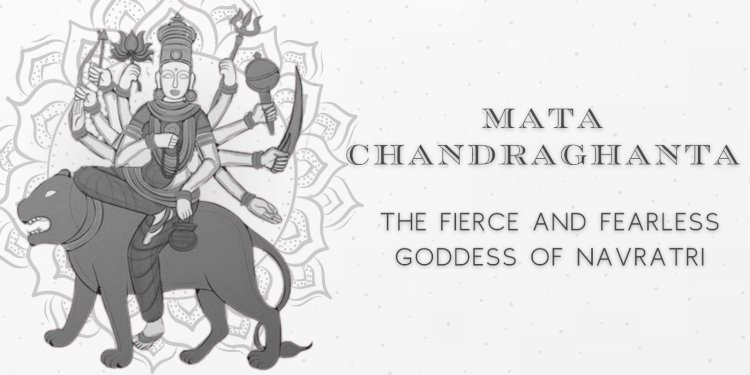Mata Chandraghanta: The Fierce and Fearless Goddess of Navratri
On the third day of Navratri, we celebrate Mata Chandraghanta, the embodiment of strength, serenity, and courage. Named for the crescent moon on her forehead and the bell she carries, this fierce form of Goddess Durga symbolizes bravery and fearlessness. The legend of Mata Chandraghanta harks back to Parvati's unwavering devotion and rigorous penance to win Lord Shiva's love, which ultimately transformed her into this formidable deity. Riding a tiger and wielding a trident, she serves as a beacon of inspiration for devotees, teaching us to confront our inner demons and emerge stronger. As we honour Mata Chandraghanta, we are reminded of the power of love, devotion, and self-transformation in our journey to attain the divine. Her luminous presence and protective nature inspire us to face life's challenges with unwavering faith and inner strength throughout the divine festival of Navratri.
By Shreya Rajvanshi Gangal

In the grand tapestry of Navratri, each day brings us closer to the divine, revealing a new facet of the goddess Durga. On the third day of this auspicious festival, we honour Mata Chandraghanta, a form of the divine mother that radiates strength, serenity, and courage. Her name, which translates to "the one with a crescent moon on her forehead," hints at her celestial grace and her unwavering commitment to vanquishing evil.
The Legend of Mata Chandraghanta
Mata Chandraghanta, the third manifestation of Goddess Durga, symbolizes bravery and fearlessness. Her name is derived from the crescent moon (Chandra) adorning her forehead and the fierce aspect of a Ghanta (bell). This powerful form of the goddess is depicted riding a tiger, wielding a trident, and adorned with a bright hue of gold. Her image inspires awe and reverence.
The legend of Mata Chandraghanta takes us back to a time when Parvati, now known as the divine mother, undertook severe penance to win Lord Shiva's heart. Her dedication and devotion were such that she decided to give up her worldly adornments, even her name and identity, as she entered into deep meditation.
As Parvati immersed herself in the divine, she faced many challenges, including the fierce elements and the relentless ardour of her devotion. Her unwavering commitment pleased Lord Shiva, who ultimately accepted her love. As a token of his affection, he adorned her forehead with a crescent moon (Chandra) and a bell (Ghanta) on her neck.
This divine transformation of Parvati into Mata Chandraghanta symbolizes the power of love, devotion, and the ability to conquer one's self to attain the divine. Mata Chandraghanta's form, riding a tiger, represents her fearlessness and determination to protect her devotees from evil forces.
Devotees celebrate the third day of Navratri by worshipping Mata Chandraghanta, seeking her blessings for courage and protection. It is a day to acknowledge the importance of confronting our inner demons and emerging stronger, just as she did in her journey to win Lord Shiva's love.
Conclusion
Mata Chandraghanta's legend serves as a powerful reminder of the inner strength, devotion, and courage needed to overcome life's challenges and adversities. As we honour her on the third day of Navratri, we draw inspiration from her story, learning to confront our fears and embrace our inner warriors.
Mata Chandraghanta's luminous presence and her ability to protect her devotees remind us that, with unwavering faith and inner strength, we can triumph over all adversities. She embodies the spirit of fearlessness and love, which resonate in our hearts and minds as we continue our journey through the divine festival of Navratri.
What's Your Reaction?



















